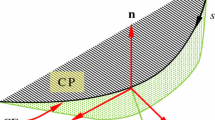Abstract
The problem of fragmentation prediction is at the origin of various analytical models. Among them, we focus on the ones introducing the idea of obscured zones. They assume that when a crack initiates at a defect, a stress release wave propagates away from the crack and protects the region encompassed by the wave from any further crack initiation. In this paper, we show by the use of numerical simulations that this assumption is only valid at high strain rates. The limit of its accuracy is even pushed to higher strain rates when the fragmentation process becomes more complex, that is to say when crack propagation, bifurcation or coalescence together with wave reflections are implied. In these cases, fragmentation lasts longer than the time needed to completely obscure the whole specimen and the obscured zone theory for fragmentation appears inadequate. We use the cohesive-element method to describe the damage and failure of the material considered.
Similar content being viewed by others
References
Astrom JA, Linna RP, Timonen J, Moller PF, Oddershede L (2004) Exponential and power-law mass distributions in brittle fragmentation. Phys Rev E 70(2): 026104
Camacho GT, Ortiz M (1996) Computational modelling of impact damage in brittle materials. Int J Solids Struct 3(20–22): 2899–2938
Denoual C, Barbier G, Hild FA (1997) Probabilistic approach for fragmentation of ceramics under impact loading. C.R. Acad Sci Paris IIb 325: 685–691
Donzé FV, Bouchez J, Magnier SA (1997) Modeling fractures in rock blasting. Int J Rock Mech Min Sci 34(8): 1153–1163
Drugan WJ (2001) Dynamic fragmentation of brittle materials: analytical mechanics-based models. J Mech Phys Solids 49(6): 1181–1208
Forquin P, Hild F (2010) A probabilistic damage model of the dynamic fragmentation process in brittle materials. Adv Appl Mech 44: 1–72
Glenn LA, Chudnovsky A (1986) Strain-energy effects on dynamic fragmentation. J Appl Phys 59: 1379–1380
Grady DE, Kipp ME (1985) Geometric statistics and dynamic fragmentation. J Appl Phys 83(3): 1210–1222
Grady DE (2006) Fragmentation of rings and shells: the legacy of N.F. Mott. Springer, Berlin
Grady DE, Kipp ME, Benson DA (1984) Energy and statistical effects in the dynamic fragmentation of metal rings. Proc Conf Mech Prop High Rates Strain 70: 315–320
Grady DE (1982) Local inertial effects in dynamic fragmentation. J Appl Phys 53(1): 322–325
Herrman HJ, Wittel FK, Kun F (2006) Fragmentation. Physica A 371: 59–66
Hughes T (2000) The finite element method: linear static and dynamic finite element analysis. Dover Publications, New York
Kipp ME, Grady DE (1985) Dynamic fracture growth and interaction in one dimension. J Mech Phys Solids 33(4): 399–415
Levy S, Molinari JF (2010) Dynamic fragmentation of ceramics, signature of defects and scaling of fragment sizes. J Mech Phys Solids 58(1): 12–26
Levy S, Molinari JF, Radovitzky R (2011) Dynamic fragmentation of a brittle plate under biaxial loading: strength or toughness controlled? Int J Numer Methods Eng (submitted)
Lienau CC (1936) Random fracture for brittle solid. J Franklin Inst 221:485–494
Maiti S, Rangaswamy K, Philippe H, Geubelle PH (2004) Mesoscale analysis of dynamic fragmentation of ceramics under tension. Acta Mater 53(3): 823–834
Miller O, Freund LB, Needleman A (1996) Modeling and simulation of dynamic fragmentation in brittle materials. Int J Fracure 96(2): 101–125
Mott NF, Linfoot EH (1943) A theory of fragmentation. Ministry of supply AC3348
Mott NF (1947) Fragmentation of shell cases. Proc Royal Soc A189: 300–308
Morris JP, Rubin MB, Block GI, Bonner PM (2006) Simulations of fracture and fragmentation of geologic materials using combined FEM/DEM analysis. Int Impact Eng 33(1–12): 463–473
Rosin P, Rammler E (1999) The laws governing the fineness of powdered coal. J Inst Fuel 7: 29–36
Weibull W (1951) A statistical distribution function of wide applicability. J Appl Mech 18: 293–297
Weibull W (1939) A statistical theory of strength of materials. The Royal Swedish Institute of Engineering Research (Ingenors Vetenskaps Akadiens Handligar) Proceeding No. 151
Zhou F, Molinari JF, Ramesh KT (2006) Analysis of the brittle fragmentation of an expanding ring. Comput Mater Sci 37(1–2): 74–85
Author information
Authors and Affiliations
Corresponding author
Rights and permissions
About this article
Cite this article
Chambart, M., Levy, S. & Molinari, J.F. How the obscuration-zone hypothesis affects fragmentation: Illustration with the cohesive-element method. Int J Fract 171, 125–137 (2011). https://doi.org/10.1007/s10704-011-9631-9
Received:
Accepted:
Published:
Issue Date:
DOI: https://doi.org/10.1007/s10704-011-9631-9




